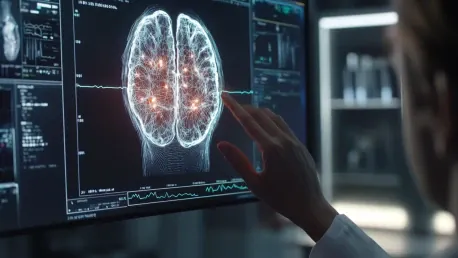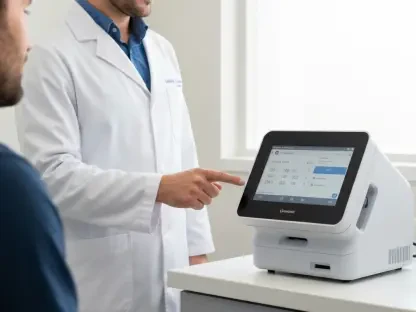The recent advancements in open-source AI models have sparked an engaging dialogue in the medical community about their potential to rival proprietary counterparts in diagnosing complex clinical cases. A National Institutes of Health (NIH)-funded study, led by researchers at Harvard Medical School, delves into this topic to uncover whether open-source AI tools can truly measure up to the best closed-source models. This exploration comes at a crucial time as the integration of artificial intelligence in healthcare continues to accelerate, promising to revolutionize how medical diagnoses are conducted and improving patient outcomes.
Benchmark Study on AI Performance
A groundbreaking study has compared the diagnostic capabilities of Llama 3.1 405B, an open-source AI model, with GPT-4, a highly recognized proprietary model. Both models were evaluated based on their performance in solving complex clinical cases sourced from The New England Journal of Medicine (NEJM). The findings demonstrated a milestone achievement, with Llama 3.1 405B matching and, at times, outperforming GPT-4 in several key aspects. This comparison not only highlights the progress made by open-source AI but also emphasizes the growing viability of these tools in clinical settings.
This study signifies a pivotal moment for open-source AI, showcasing its ability to compete head-to-head with proprietary models. The analysis covered a range of diagnostic scenarios, testing the models’ accuracy and reliability across a spectrum of medical conditions. As AI technology advances, the implications of such findings could be far-reaching, influencing the future development and application of AI in healthcare. The results from this study set a new standard for what open-source AI can achieve, potentially driving further innovation and adoption in the medical field.
Results and Key Comparisons
In a direct performance comparison, Llama 3.1 405B managed to correctly diagnose 70% of the 92 complex cases, while GPT-4 trailed with a 64% success rate. Impressively, Llama’s first diagnosis suggestion proved correct 41% of the time, slightly edging out GPT-4, which had a 37% success rate for initial recommendations. These results mark a significant advance for open-source AI models in the medical field. The ability of Llama 3.1 405B to provide accurate diagnostics on par with, and occasionally surpass, its proprietary counterpart demonstrates the narrowing gap between these model types.
These findings are not only statistically significant but also symbolically important, as they challenge the long-standing notion that proprietary models possess an insurmountable edge in accuracy and performance. With open-source models now proving their mettle, the landscape of medical AI is poised for transformation. The competitive performance of Llama 3.1 405B suggests that open-source AI is ready for broader implementation, offering healthcare providers a viable alternative to proprietary solutions without compromising on diagnostic quality.
Advantages of Open-Source AI in Healthcare
Open-source AI models offer considerable benefits, including the ability to customize and fine-tune systems based on specific local data sets. This flexibility is particularly advantageous for healthcare institutions aiming to address unique clinical needs. Additionally, these models help maintain patient data in-house, addressing prevalent concerns regarding data privacy and security associated with proprietary models that require external data transfer. The intrinsic transparency of open-source models enables institutions to adapt AI tools more precisely to their workflows and patient demographics, ensuring better alignment with clinical requirements.
Moreover, the cost-effectiveness of open-source AI represents a significant advantage, particularly for resource-constrained healthcare settings. The absence of licensing fees and the availability of community support can dramatically reduce the financial burden on institutions. This financial accessibility means that advanced diagnostic capabilities can be extended to a broader array of healthcare facilities, potentially reducing disparities in healthcare quality and outcome. By leveraging open-source AI, hospitals and clinics can enhance their diagnostic arsenal while maintaining control over sensitive patient information.
Implementation Challenges
Despite their promising capabilities, open-source AI models come with implementation challenges. These models may lack the traditional customer support and seamless integration with existing health IT systems that proprietary models offer. Setting up and maintaining open-source solutions often demands considerable effort and technical expertise from healthcare providers, presenting a barrier to widespread adoption. The need for in-house expertise and resources to manage and optimize these models can be daunting for institutions without robust IT infrastructure or specialist personnel, necessitating significant investment in training and development.
Furthermore, the iterative nature of open-source models requires continuous monitoring and fine-tuning to maintain optimal performance. Unlike proprietary solutions, which often come with regular updates and support services, open-source models rely on community contributions and institutional initiatives for enhancements and troubleshooting. This ongoing requirement can strain the operational capacity of healthcare providers, potentially hindering the full realization of the models’ benefits. Addressing these challenges will be crucial to unlocking the full potential of open-source AI in medical diagnostics.
Potential and Applications
The competitive performance of open-source models could democratize access to advanced diagnostic tools across healthcare settings, especially in resource-limited environments. This increasing competitiveness may drive innovation in the field, leading to reduced costs and greater accessibility of sophisticated AI tools. The potential for widespread deployment of open-source AI could herald a new era of innovation and improve patient outcomes across diverse healthcare settings. By making cutting-edge diagnostic technology more accessible, open-source AI can contribute to more equitable healthcare delivery and further advances in medical science.
One of the most promising applications of open-source AI is its integration into telemedicine and remote diagnostics, where it can assist in delivering high-quality medical consultations and advice to underserved populations. Open-source models’ adaptability and cost-efficiency make them ideal for these contexts, where traditional medical infrastructure may be lacking or insufficient. As telehealth continues to expand, the synergy between open-source AI and remote medical services could provide critical support to practitioners and enhance the quality of care received by patients worldwide.
Future Directions
The recent advancements in open-source AI models have ignited a compelling discussion within the medical community about their ability to compete with proprietary models in diagnosing intricate clinical cases. A study funded by the National Institutes of Health (NIH) and carried out by researchers at Harvard Medical School investigates whether open-source AI tools can genuinely rival the best closed-source models. This exploration is particularly timely as the integration of artificial intelligence in healthcare is rapidly gaining momentum, promising to transform the process of medical diagnoses and enhance patient outcomes. The study aims to assess the effectiveness, reliability, and accuracy of open-source AI models compared to their proprietary counterparts, potentially democratizing access to cutting-edge diagnostic tools. As AI technology continues to evolve, the findings from this research could play a pivotal role in shaping the future of medical diagnostics, bridging gaps in accessibility, and fostering innovation in patient care.









